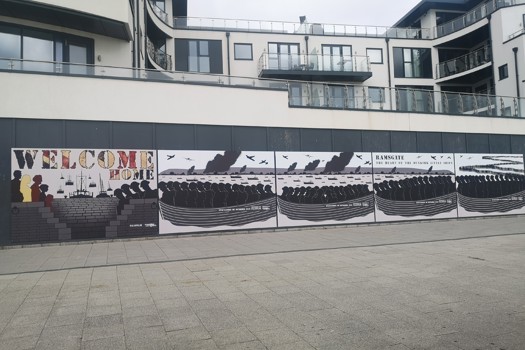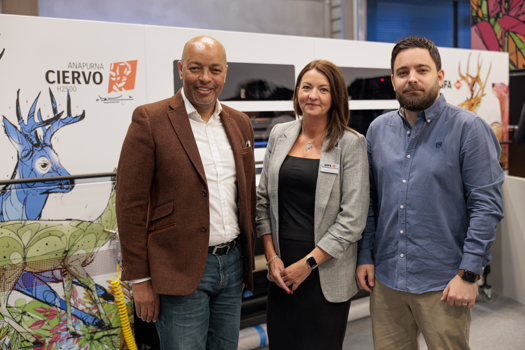The printer must be able to find the right combination of inks and the best substrate to reproduce as accurately as possible the artist’s creative vision. It is one of the few areas of print where the dark arts are still employed and where those who do it well can afford to charge a premium for their skills.
This is perhaps the reason why few commercial printers have managed to gain a foothold in this sector. It is more of a craft – a cottage industry consisting of thousands of small outfits, many of whom are one-man-and-a-press-in-a-workshop operations.
With art sales on the up, this niche market is seeing strong growth at present and is attracting a lot of attention from printers whose margins are dwindling elsewhere. But what do printers looking to enter this market need to be aware of?
First, it’s important to note that if you’re a Joe Bloggs commercial printer with a state-of-the-art litho press, there isn’t going to be enough work from the fine art market alone to feed your machine.
One commercial printer who was recently nominated for a fine art printing award claims that focusing solely on fine art work just isn’t a sustainable business model. “We do a little bit of it,” he explains, “but it’s mainly one-offs because there’s not enough to keep the presses ticking over.”
This is because print runs are typically short – except perhaps on items such as gallery catalogues, brochures and books – and more time needs to be invested in the pre-press side of the jobs than for run-of-the-mill work. A second factor worth noting is that if you want to do this kind of work well, and make it a serious part of your business offer, then it’s going to cost you a handsome sum, for you will need to invest in the right kind of kit to reach the required standards demanded by the sector.
However, Roland Clarke of Portsmouth-based giclée fine art print specialist ArtChroma says that this type of investment decision is counter-intuitive for most businesses. “They believe that it’s logically better to spend the least and be able to take on the widest variety of work,” he says. “But doing this is going to make capturing the most lucrative work almost impossible.”
You’ll need to put as much of the financial outlay into image capture equipment as on the press, according to Craig Buckland of Bridgend-based print firm The Dot Foundry, which offers photographic and giclée work. Buckland says that the company was set up three years ago after identifying that there was a lack of printers that could produce high quality, short-run reproductions.
“Some commercial printers could do the printing, but they didn’t have image capture facilities, so these had to be sourced separately by the artist. However, image capture people, when they could be found, were usually unaware of the best way to photograph artwork with consistent colour quality.”
So The Dot Foundry invested heavily in specialist photographic and lighting kit and now offers image capture as part of its overall service to a list of clients that includes established artists and photographers.
Another company that took a similar investment approach is Newark-based digital print firm Sally Mitchell Fine Arts. It started out as a publisher, but as it moved slowly into printing, owner Sally Mitchell realised early on that she needed equipment that could scan and print to a high standard. She opted for the combination of a Cruse flatbed scanner and Roland wide-format presses, which enables the firm to offer a one-stop service.
“In the old days we would have had to go somewhere to get the image reproduced, but the problem was that it’s really difficult to light the picture evenly,” she says. “Now you can bring the painting into the studio and we can create a print within 30 minutes that’s better quality than we could have produced in the past.”
Although the advent of this type of image capture equipment was important for the sector, the watershed moment for fine art printers came with the radical improvements in quality offered by digital technology.
One of the first photographic companies to move into fine art work was Redcliffe Imaging, in Bristol, which was at one point involved with HP Labs doing research and development work on scanning image libraries.
According to Redcliffe director Tim Sale, the firm gained a lot of experience of scanning and digital imaging from these trials, and as photographic services went increasingly digital he decided to change the firm’s business model. Today, Redcliffe produces exhibitions and display work in addition to its fine art output.
“The thing about digital is that it has blurred a lot of boundaries in the same way that DTP killed typesetting and the desktop scanners killed repro,” explains Sale. “A lot of what we do might traditionally have been done by screen printers, but digital is quicker and there are no set-up costs.”
Other than the occasional bespoke use of screen printing (see box, above) digital has emerged as the weapon of choice for fine art printers with litho all but forgotten, according to Mitchell. “We used to do all work on litho, but now we don’t do any litho work,” she explains. “With giclée you can afford to be more experimental. If you print one and it doesn’t work then it means that you don’t have the 499 other prints that you would have with litho that you then have to store and sell.”
With digital you also don’t need a vast armoury of extremely expensive presses to create a going concern. ArtChroma’s Clarke uses a single large-format Epson inkjet printer and three media types – fine art paper, canvas and poster paper. The equipment has been calibrated and profiled for the three products, and on the back of this offer Clarke has secured high-profile artists as customers, including Antony Micallef and Radiohead collaborator Stanley Donwood, alongside a number of well-known designers and illustrators.
While profits on print runs can be quite tight, Clarke makes his margin on selling his unique skills. “The job’s costs are the material cost with mark-up, but the mark-up is higher than normal because of the short runs and the amount of work, or expertise, required to achieve the right result.”
Beacon Press sales and marketing director Richard Owers says that this type of mark-up is accepted by customers, who realise that they have to pay a premium for fine art work because there are very few individuals armed with the right skills and knowledge to undertake commissions of this nature.
“There are two or three of us here [at Beacon Press] that have that knowledge and we’re almost like a fine art print consultant to the client. We discuss the project with them and consult about all aspects of production, from testing screen rulings through to changing from CMYK to a more bespoke ink set that better matches the artist’s palette. That sort of ‘before the press’ activity is pretty unusual in this PDF world that we live in today and it’s something that you can’t put a value on – it doesn’t appear on any estimating system.”
A major part of this skill-set is understanding colour, having an eye for detail and having intimate knowledge of the subject matter. Much of it is intuitive and comes from years of on-the-job experience, says Redcliffe’s Sale. “You see it a lot in print, where people check that the numbers are correct and then they press all the buttons and put the files through, but it doesn’t come out right in the end and they don’t know why. Our technicians are former photographic technicians who are very good at looking at images and this enables us to make very good prints. We get an image and we use our skill and judgment to make the best print that we can. Some people can’t do that.”
ArtChroma’s Clarke concurs with Sale’s assessment, adding that selling a unique skill and providing value that rival operators cannot offer is the way forward for printers, no matter what part of the industry they operate in.
“Losing work to overseas suppliers is inevitable,” he says. “The only way forward is to target a niche and provide a product or service that exceeds what is offered by the one-stop shop firms who offer everything at bulk discount.”
FINE ART FROM THE STREET
Screen print enjoys a revival
While digital has stolen a march on what might traditionally have been considered screen print’s home turf, recent years have seen a growing band of artist-printer collectives picking up their squeegees and learning the art of screen printing.
At the forefront of this movement is London-based print shop Pictures on Walls (POW), which produces limited edition runs of work for the likes of graffiti artist Banksy. But POW is not like a normal print shop. A lot of the screen-printed work is embellished by hand after printing using paints or stencils and spray cans in a similar way to how Andy Warhol finished his Pop Art screen prints. And the great thing for POW’s printer, a street artist by the name of Eine (pronounced like ‘wine’), is that his clients are not that bothered about the overall finish. “It’s street art, so there’s lots of noise and dribbles of paint,” he says, “so you can get away with it being quite scrappy.”
POW has spawned a series of similar operations, such as Black Rat Press and Souled Out Studios, which both print and sell work by street artists. These companies do it as much for the love of print as for the art itself and this means that much of the work goes on sale at very affordable rates that cover the cost of production with a small profit on top.
GICLÉE VS LITHO
How it works
Giclée printing has provided a unique selling opportunity for artists who do not wish to mass-produce their work. Once a scan is made, either directly or via a transparency, it is possible to make as many or as few copies as required.
Giclée prints are usually made by large-format ink-jet printers of eight colours or more. Thanks to piezo ink-jet technology, the colour gamut is greater than traditional screen or litho printing methods and there is no visible dot screen pattern. The digital images can be reproduced to any format the inkjet printer can handle and to a numerous range of substrates, including canvas.
In contrast, printing a single copy of artwork on a typical four-colour sheetfed press is economically prohibitive due to the plate-making costs and makeready involved. A run of 1,000 will incur further storage charges and ultimately only lower the value of the individual sheet.
In the past couple of years, giclée prints by photgraphers Annie Leibovitz and Wolfgang Tillmans have fetched five-figure sums at auction, and are often found hanging in museums and galleries.








